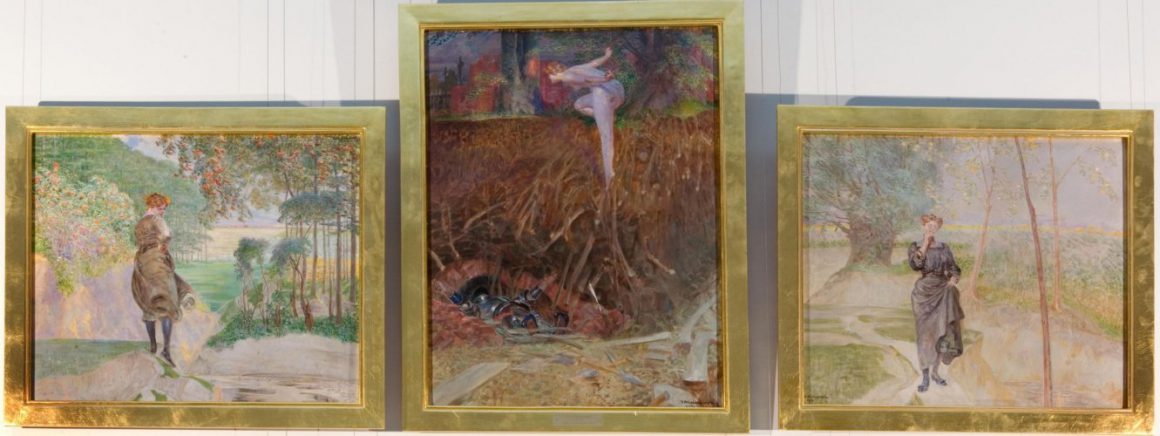Description:
Jack Malczewski (1854-1929) had a passion for art and romantic literature, especially the poetry of Juliusz Slowacki, which he inherited from his family. He came from a noble but not wealthy family. His father Julian supported him in his painting career. The events of 1863, the January Uprising and subsequent repression, left a deep imprint on the young artist. His first mentor was Adolf Dygasinski. During the period of 1867-1871 he spent time in the manor of his uncle Karczewski in Wielgim. In 1873 he began his studies at the Krakow Academy of Fine Arts under the direction of Jan Matejko. He was a student of Wladyslaw Luszczkiewicz. He also studied at the École des Beaux-Arts in Paris. He traveled to Italy, Vienna, Munich, Greece and Minor Asia. From 1896 to 1900 and from 1910 to 1914 he was a professor at the Academy of Fine Arts in Krakow. In 1912-1914 he was its rector. He began with an idealizing realism, then naturalism, and the main theme of his work in this period was the fate of the exiles to Siberia and the inspiration of Juliusz Slowacki’s “Anhellim”. At the same time, fantastic and allegorical representations began to appear in Malczewski’s work. After his father’s death in 1884, the recurring motif in Malczewski’s work was Thanatos – the god of death. After 1890, his art became entirely symbolic. Works that manifest the turn towards the symbolism style are: “Introduction” 1890, “Melancholy” 1890-1894, “Vicious Circle” 1895-1897. The artist dealt with existential, historical and the position of the artist, his obligations to the homeland and the condition of art. He intertwined ancient and biblical motifs with native folklore and the Polish landscape, which is so important in his works. Form, color, monumentality of presentations, and their expressiveness became his distinguishing marks.
Malczewski once again invites us to discover an extraordinary history, certainly presented in an extraordinary way, as self-ironic. The painter, fond of the works of Juliusz Słowacki, took from his family home. His father was an avid reader of his works. “Beniowski” is called a digressive poem and is considered one of the more interesting works in the history of Polish literature. Maurycy Kaźmierz Zbigniew Beniowski, from the outset a character of average and unremarkable, aroused the interest of the painter with his attitude. As a literary hero, he had practically no influence on his destiny. He was passively subject to the course of events. When he arrived in Bar, instead of taking part in the battles, he decided to… observe the dancing doves.
It is not surprising, therefore, that in “Triptych to Beniowski” it is the women who dominate the performance. In three views forming the whole, the same figure was presented – Aniela. She took on the features of the great love of the painter, Maria Balowa. Aniela is a young, wealthy maiden, the former fiancée of Beniowski. Her father forbade her contact with the man after he lost all his fortune.
In the left part of Malczewski’s triptych, Aniela goes to a secret rendezvous with her beloved to a nearby clay hut of a fortune-teller, predicting the future. In the background you can see the trees of the service tree, a magical plant protecting from evil spirits and powers. In the right part of the triptych, the woman is already returning to the castle, as it is starting to get dark. What happened between the lovers during the meeting, the narrator remains silent about. Aniela becomes a model of a typical 19th-century hero: sentimental, lyrical and pompous. The role that was previously played by romantic male heroes is now taken by… a woman.
Beniowski leaves his beloved and sets off on a journey into the unknown. He sees battles, but does not take part in them. On his way, he encounters dancing doves, a symbol of love. Following them, the enchanted knight finds an old tree – “the oak from the times of Krak” – the symbolic Tree of Life here. At its feet, Malczewski painted a knight lying in his grave. However, he will not remain alone for long. The naked, white soul of his beloved Aniela descends to the Underworld. She leaves the world of the living, with the outline of her father’s castle – the Starost, and two Bars crosses commemorating bloody battles. Now she will be forever united with her beloved. He fulfills the promise he made to her: “Dead, I will open your arms in the grave, when you come, like a pale rose, to fall asleep” (Song IV “Beniowski”). Thus, the central part of the triptych foreshadows the joint happiness after death in heaven for those who were not able to experience happiness on Earth.
Just like Słowacki, Malczewski does not paint a noble figure with heroic destiny and strength. The artist focuses on the naturally fragile being that is a woman. The knight lying at the “foot of the work” was not a support for her, he did not take up the fight, so all that was left to him was hope, or rather certainty, that after death he will experience happiness.


